Business Strategy and Strategic Analysis of Tesco PLC Report
VerifiedAdded on 2020/10/05
|22
|6676
|306
Report
AI Summary
This report provides a comprehensive strategic analysis of Tesco PLC, a multinational retailer. It begins with an introduction to Tesco, detailing its background, mission, vision, and objectives. The report then examines the impact of the macro-environment on Tesco using PESTLE analysis, considering political, economic, social, technological, legal, and environmental factors. It also includes a stakeholder analysis, identifying key stakeholders and their influence on the company. The internal environment and capabilities of Tesco are assessed using Porter's Value Chain and McKinsey 7S model. The competitive forces within the retail industry are evaluated using Porter's Five Forces model. Finally, the report concludes by devising a strategic plan for Tesco, based on the preceding analyses. The report highlights Tesco's strengths, weaknesses, opportunities, and threats, offering insights into its market position and future strategies.
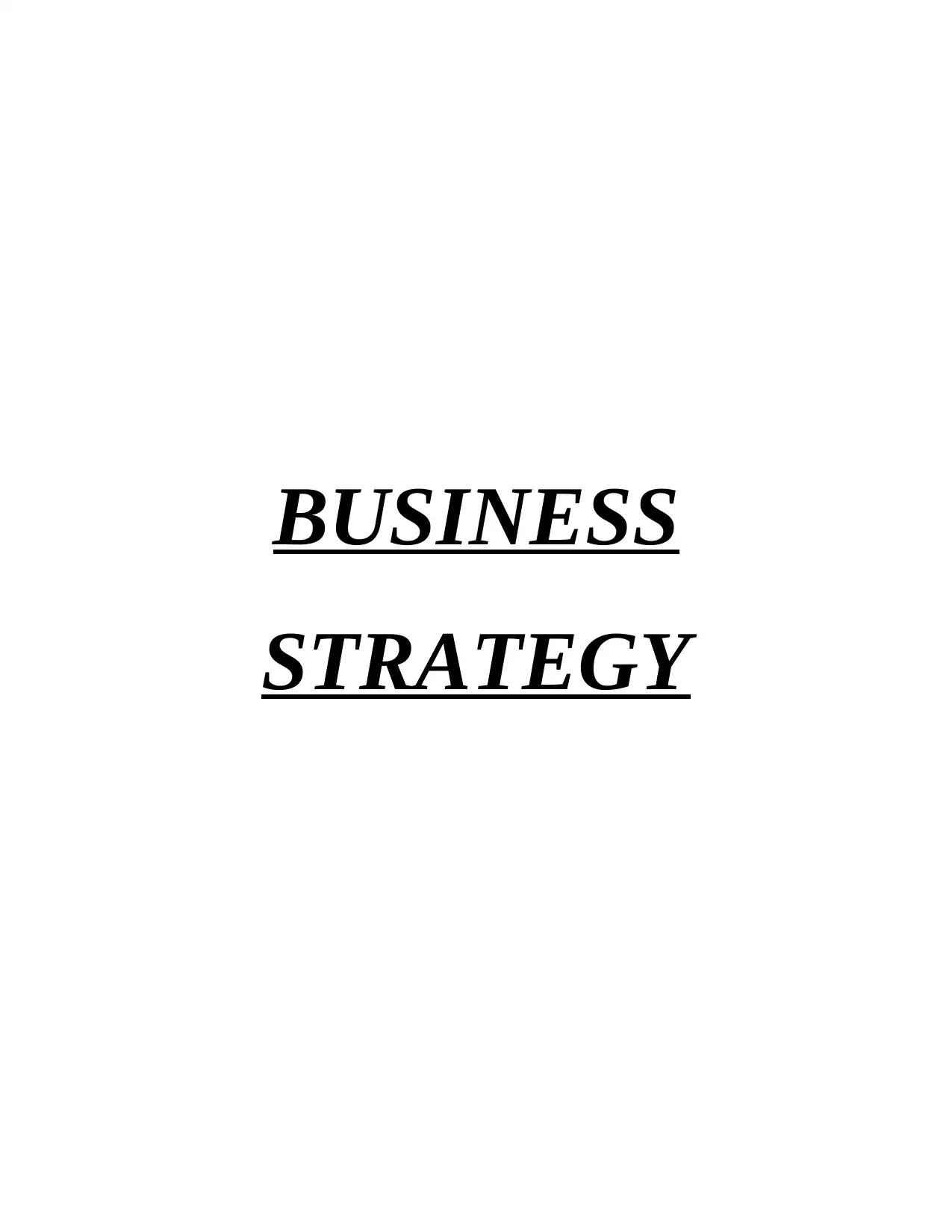
BUSINESS
STRATEGY
STRATEGY
Paraphrase This Document
Need a fresh take? Get an instant paraphrase of this document with our AI Paraphraser
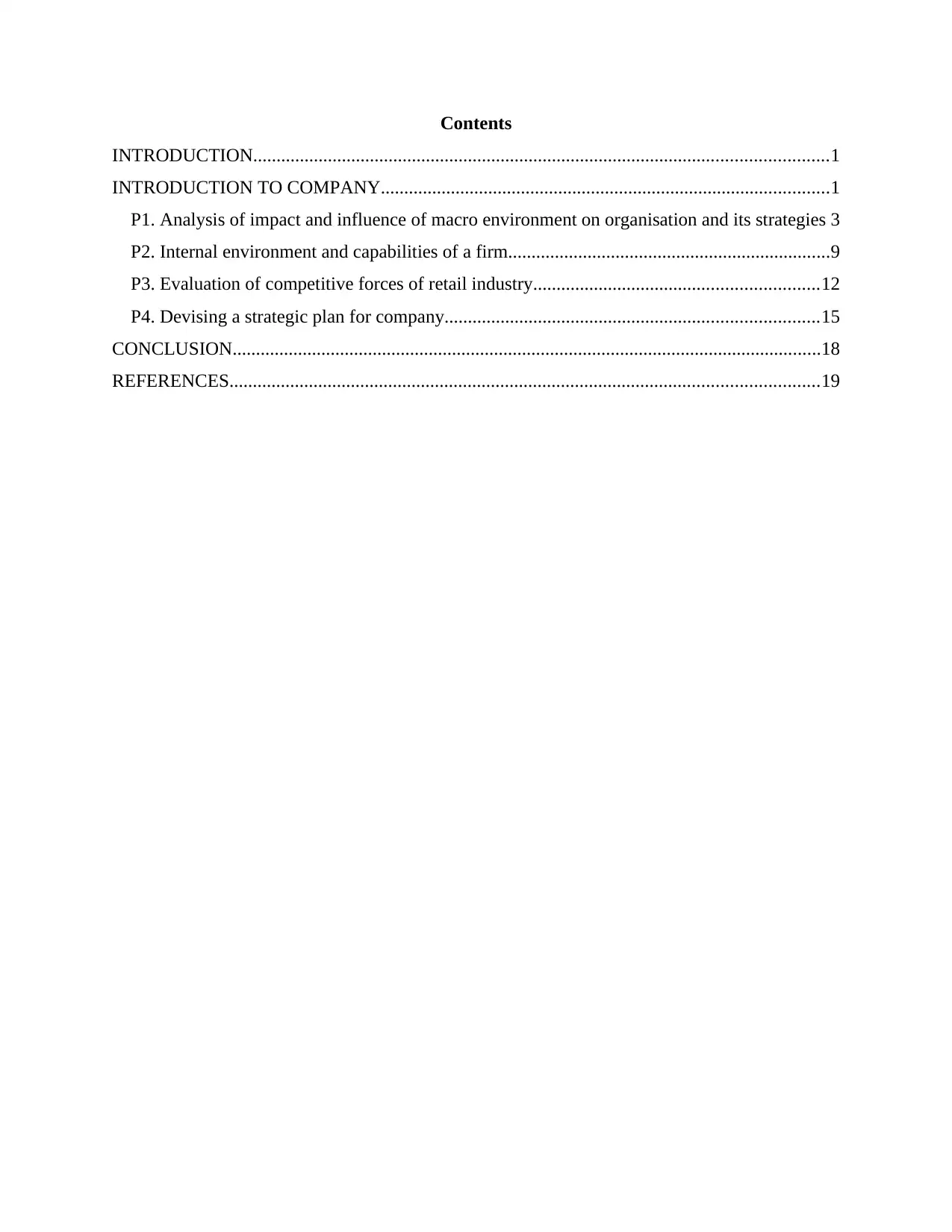
Contents
INTRODUCTION...........................................................................................................................1
INTRODUCTION TO COMPANY................................................................................................1
P1. Analysis of impact and influence of macro environment on organisation and its strategies 3
P2. Internal environment and capabilities of a firm.....................................................................9
P3. Evaluation of competitive forces of retail industry.............................................................12
P4. Devising a strategic plan for company................................................................................15
CONCLUSION..............................................................................................................................18
REFERENCES..............................................................................................................................19
INTRODUCTION...........................................................................................................................1
INTRODUCTION TO COMPANY................................................................................................1
P1. Analysis of impact and influence of macro environment on organisation and its strategies 3
P2. Internal environment and capabilities of a firm.....................................................................9
P3. Evaluation of competitive forces of retail industry.............................................................12
P4. Devising a strategic plan for company................................................................................15
CONCLUSION..............................................................................................................................18
REFERENCES..............................................................................................................................19
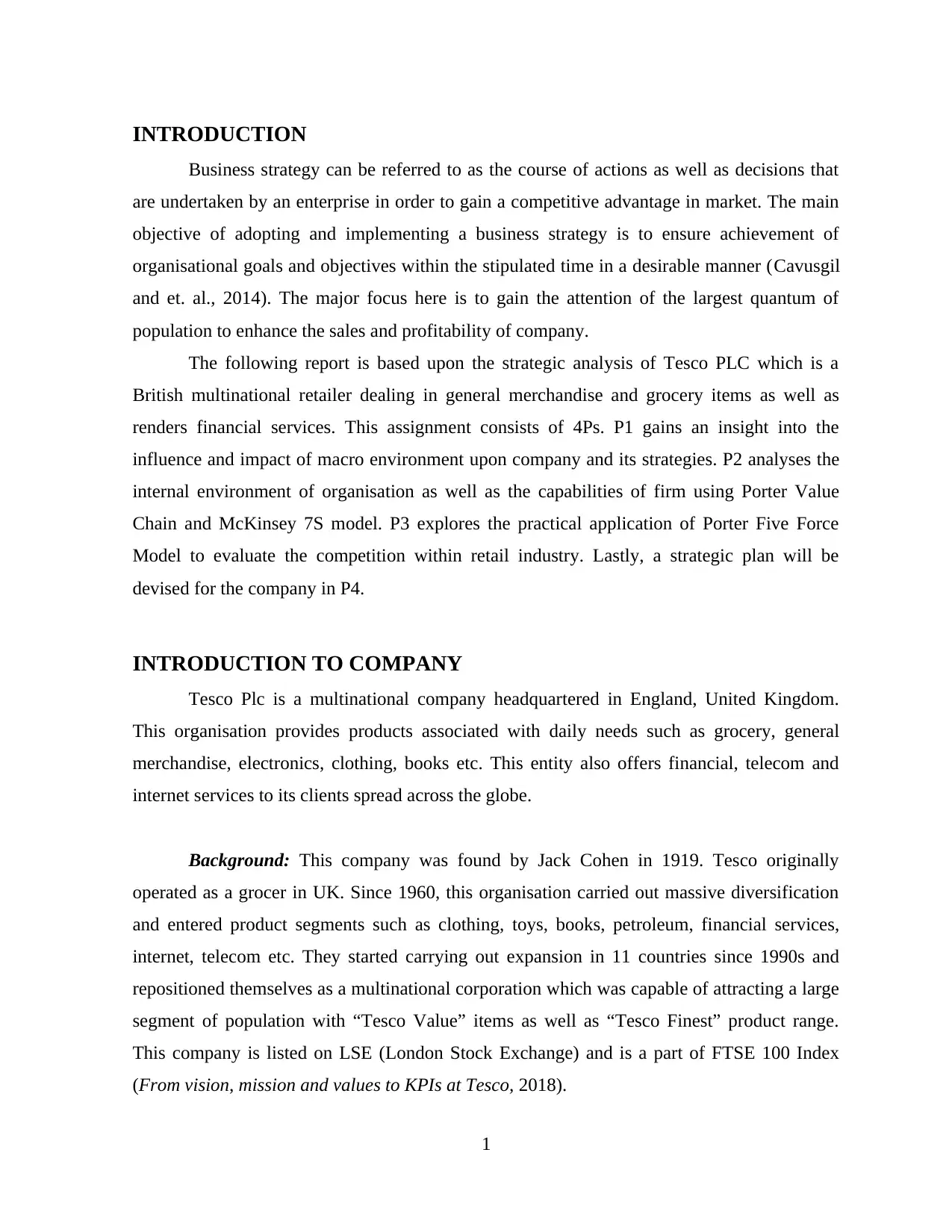
INTRODUCTION
Business strategy can be referred to as the course of actions as well as decisions that
are undertaken by an enterprise in order to gain a competitive advantage in market. The main
objective of adopting and implementing a business strategy is to ensure achievement of
organisational goals and objectives within the stipulated time in a desirable manner (Cavusgil
and et. al., 2014). The major focus here is to gain the attention of the largest quantum of
population to enhance the sales and profitability of company.
The following report is based upon the strategic analysis of Tesco PLC which is a
British multinational retailer dealing in general merchandise and grocery items as well as
renders financial services. This assignment consists of 4Ps. P1 gains an insight into the
influence and impact of macro environment upon company and its strategies. P2 analyses the
internal environment of organisation as well as the capabilities of firm using Porter Value
Chain and McKinsey 7S model. P3 explores the practical application of Porter Five Force
Model to evaluate the competition within retail industry. Lastly, a strategic plan will be
devised for the company in P4.
INTRODUCTION TO COMPANY
Tesco Plc is a multinational company headquartered in England, United Kingdom.
This organisation provides products associated with daily needs such as grocery, general
merchandise, electronics, clothing, books etc. This entity also offers financial, telecom and
internet services to its clients spread across the globe.
Background: This company was found by Jack Cohen in 1919. Tesco originally
operated as a grocer in UK. Since 1960, this organisation carried out massive diversification
and entered product segments such as clothing, toys, books, petroleum, financial services,
internet, telecom etc. They started carrying out expansion in 11 countries since 1990s and
repositioned themselves as a multinational corporation which was capable of attracting a large
segment of population with “Tesco Value” items as well as “Tesco Finest” product range.
This company is listed on LSE (London Stock Exchange) and is a part of FTSE 100 Index
(From vision, mission and values to KPIs at Tesco, 2018).
1
Business strategy can be referred to as the course of actions as well as decisions that
are undertaken by an enterprise in order to gain a competitive advantage in market. The main
objective of adopting and implementing a business strategy is to ensure achievement of
organisational goals and objectives within the stipulated time in a desirable manner (Cavusgil
and et. al., 2014). The major focus here is to gain the attention of the largest quantum of
population to enhance the sales and profitability of company.
The following report is based upon the strategic analysis of Tesco PLC which is a
British multinational retailer dealing in general merchandise and grocery items as well as
renders financial services. This assignment consists of 4Ps. P1 gains an insight into the
influence and impact of macro environment upon company and its strategies. P2 analyses the
internal environment of organisation as well as the capabilities of firm using Porter Value
Chain and McKinsey 7S model. P3 explores the practical application of Porter Five Force
Model to evaluate the competition within retail industry. Lastly, a strategic plan will be
devised for the company in P4.
INTRODUCTION TO COMPANY
Tesco Plc is a multinational company headquartered in England, United Kingdom.
This organisation provides products associated with daily needs such as grocery, general
merchandise, electronics, clothing, books etc. This entity also offers financial, telecom and
internet services to its clients spread across the globe.
Background: This company was found by Jack Cohen in 1919. Tesco originally
operated as a grocer in UK. Since 1960, this organisation carried out massive diversification
and entered product segments such as clothing, toys, books, petroleum, financial services,
internet, telecom etc. They started carrying out expansion in 11 countries since 1990s and
repositioned themselves as a multinational corporation which was capable of attracting a large
segment of population with “Tesco Value” items as well as “Tesco Finest” product range.
This company is listed on LSE (London Stock Exchange) and is a part of FTSE 100 Index
(From vision, mission and values to KPIs at Tesco, 2018).
1
⊘ This is a preview!⊘
Do you want full access?
Subscribe today to unlock all pages.

Trusted by 1+ million students worldwide
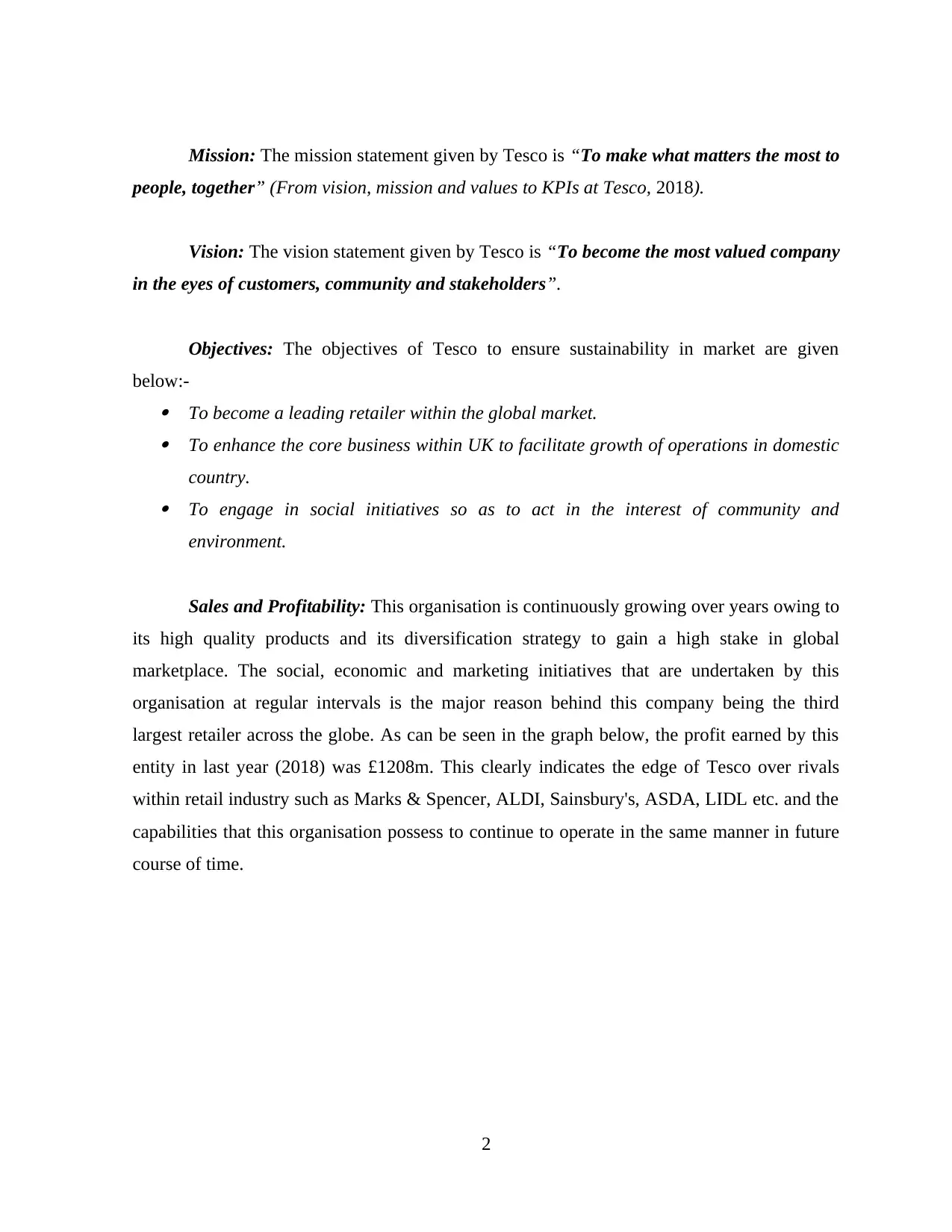
Mission: The mission statement given by Tesco is “To make what matters the most to
people, together” (From vision, mission and values to KPIs at Tesco, 2018).
Vision: The vision statement given by Tesco is “To become the most valued company
in the eyes of customers, community and stakeholders”.
Objectives: The objectives of Tesco to ensure sustainability in market are given
below:-
To become a leading retailer within the global market.
To enhance the core business within UK to facilitate growth of operations in domestic
country.
To engage in social initiatives so as to act in the interest of community and
environment.
Sales and Profitability: This organisation is continuously growing over years owing to
its high quality products and its diversification strategy to gain a high stake in global
marketplace. The social, economic and marketing initiatives that are undertaken by this
organisation at regular intervals is the major reason behind this company being the third
largest retailer across the globe. As can be seen in the graph below, the profit earned by this
entity in last year (2018) was £1208m. This clearly indicates the edge of Tesco over rivals
within retail industry such as Marks & Spencer, ALDI, Sainsbury's, ASDA, LIDL etc. and the
capabilities that this organisation possess to continue to operate in the same manner in future
course of time.
2
people, together” (From vision, mission and values to KPIs at Tesco, 2018).
Vision: The vision statement given by Tesco is “To become the most valued company
in the eyes of customers, community and stakeholders”.
Objectives: The objectives of Tesco to ensure sustainability in market are given
below:-
To become a leading retailer within the global market.
To enhance the core business within UK to facilitate growth of operations in domestic
country.
To engage in social initiatives so as to act in the interest of community and
environment.
Sales and Profitability: This organisation is continuously growing over years owing to
its high quality products and its diversification strategy to gain a high stake in global
marketplace. The social, economic and marketing initiatives that are undertaken by this
organisation at regular intervals is the major reason behind this company being the third
largest retailer across the globe. As can be seen in the graph below, the profit earned by this
entity in last year (2018) was £1208m. This clearly indicates the edge of Tesco over rivals
within retail industry such as Marks & Spencer, ALDI, Sainsbury's, ASDA, LIDL etc. and the
capabilities that this organisation possess to continue to operate in the same manner in future
course of time.
2
Paraphrase This Document
Need a fresh take? Get an instant paraphrase of this document with our AI Paraphraser
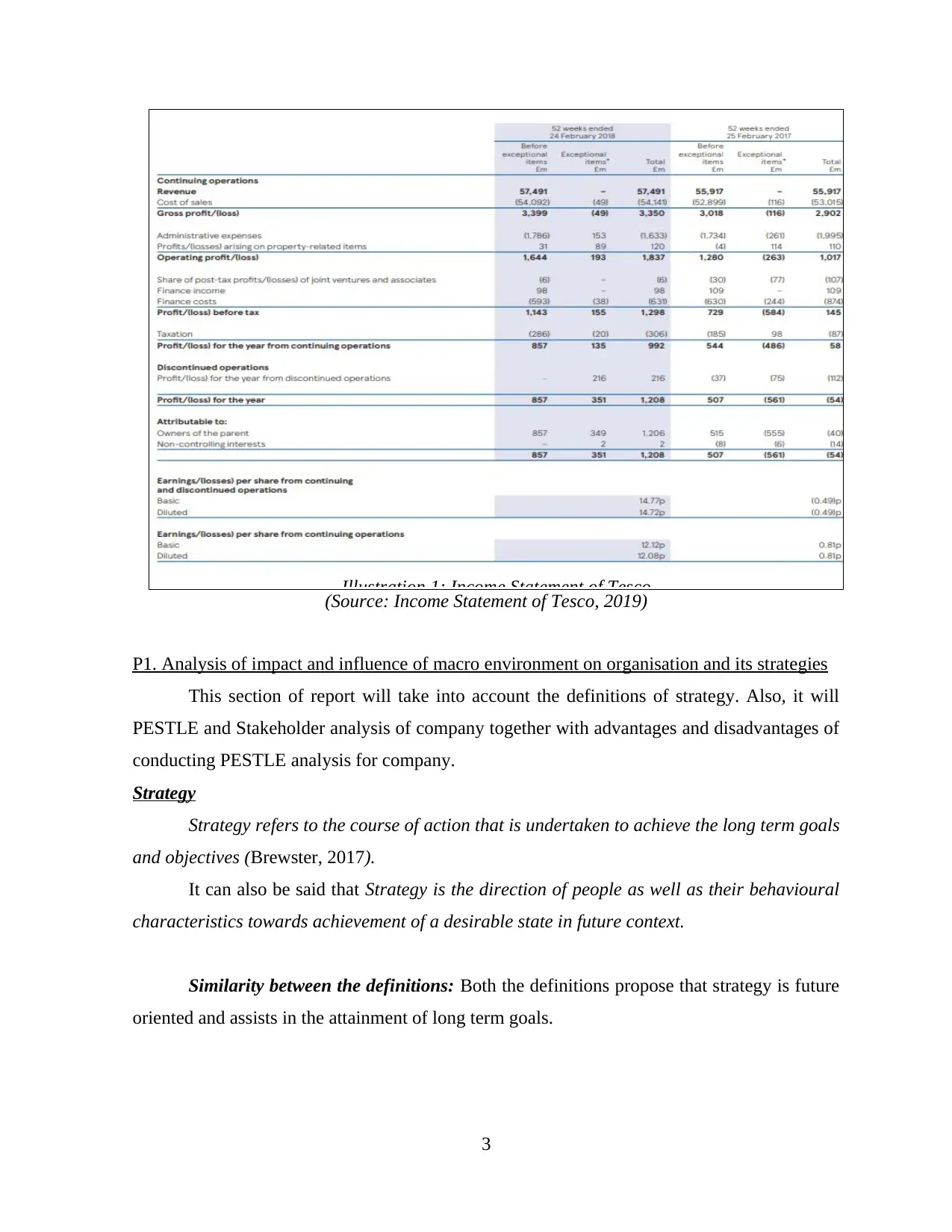
(Source: Income Statement of Tesco, 2019)
P1. Analysis of impact and influence of macro environment on organisation and its strategies
This section of report will take into account the definitions of strategy. Also, it will
PESTLE and Stakeholder analysis of company together with advantages and disadvantages of
conducting PESTLE analysis for company.
Strategy
Strategy refers to the course of action that is undertaken to achieve the long term goals
and objectives (Brewster, 2017).
It can also be said that Strategy is the direction of people as well as their behavioural
characteristics towards achievement of a desirable state in future context.
Similarity between the definitions: Both the definitions propose that strategy is future
oriented and assists in the attainment of long term goals.
3
Illustration 1: Income Statement of Tesco
P1. Analysis of impact and influence of macro environment on organisation and its strategies
This section of report will take into account the definitions of strategy. Also, it will
PESTLE and Stakeholder analysis of company together with advantages and disadvantages of
conducting PESTLE analysis for company.
Strategy
Strategy refers to the course of action that is undertaken to achieve the long term goals
and objectives (Brewster, 2017).
It can also be said that Strategy is the direction of people as well as their behavioural
characteristics towards achievement of a desirable state in future context.
Similarity between the definitions: Both the definitions propose that strategy is future
oriented and assists in the attainment of long term goals.
3
Illustration 1: Income Statement of Tesco
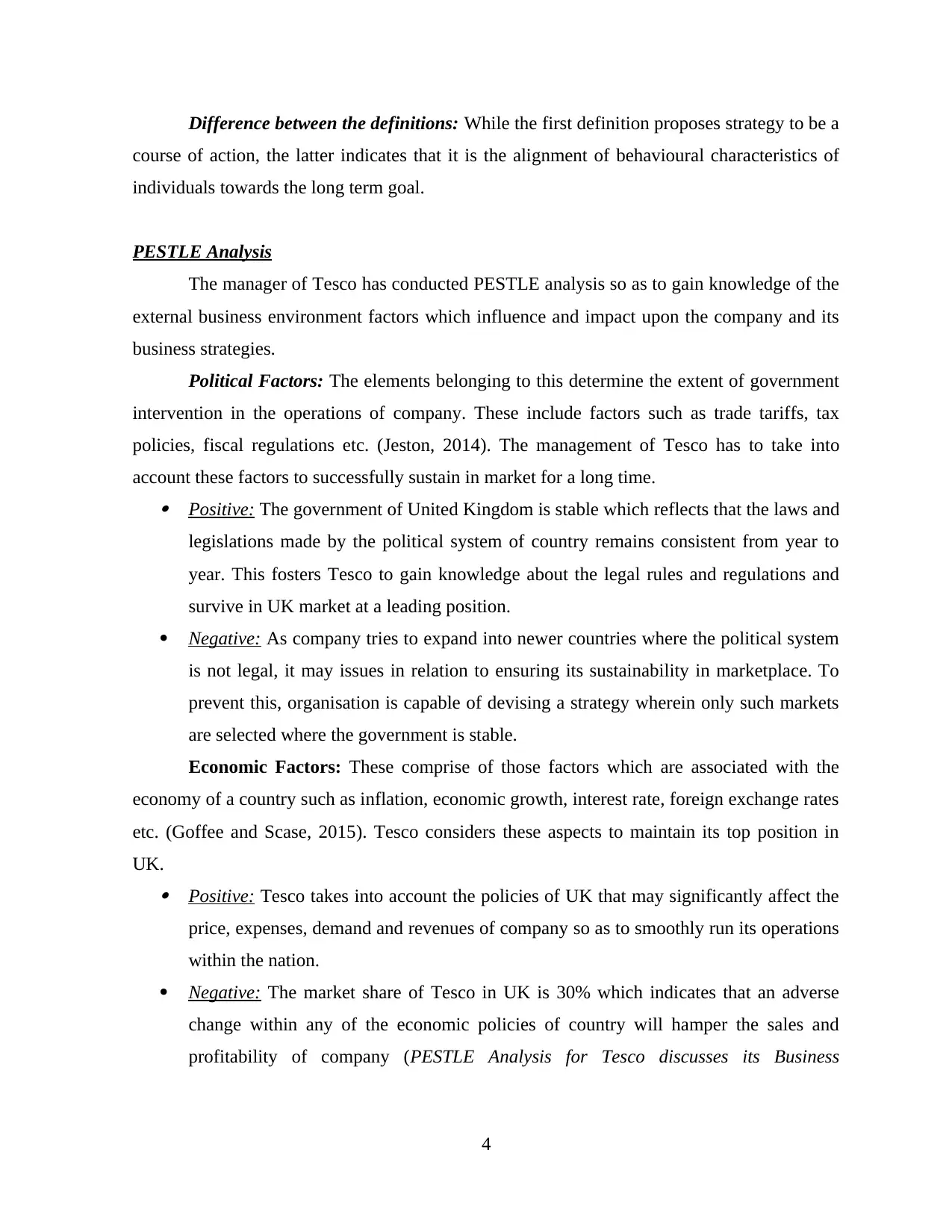
Difference between the definitions: While the first definition proposes strategy to be a
course of action, the latter indicates that it is the alignment of behavioural characteristics of
individuals towards the long term goal.
PESTLE Analysis
The manager of Tesco has conducted PESTLE analysis so as to gain knowledge of the
external business environment factors which influence and impact upon the company and its
business strategies.
Political Factors: The elements belonging to this determine the extent of government
intervention in the operations of company. These include factors such as trade tariffs, tax
policies, fiscal regulations etc. (Jeston, 2014). The management of Tesco has to take into
account these factors to successfully sustain in market for a long time.
Positive: The government of United Kingdom is stable which reflects that the laws and
legislations made by the political system of country remains consistent from year to
year. This fosters Tesco to gain knowledge about the legal rules and regulations and
survive in UK market at a leading position.
Negative: As company tries to expand into newer countries where the political system
is not legal, it may issues in relation to ensuring its sustainability in marketplace. To
prevent this, organisation is capable of devising a strategy wherein only such markets
are selected where the government is stable.
Economic Factors: These comprise of those factors which are associated with the
economy of a country such as inflation, economic growth, interest rate, foreign exchange rates
etc. (Goffee and Scase, 2015). Tesco considers these aspects to maintain its top position in
UK. Positive: Tesco takes into account the policies of UK that may significantly affect the
price, expenses, demand and revenues of company so as to smoothly run its operations
within the nation.
Negative: The market share of Tesco in UK is 30% which indicates that an adverse
change within any of the economic policies of country will hamper the sales and
profitability of company (PESTLE Analysis for Tesco discusses its Business
4
course of action, the latter indicates that it is the alignment of behavioural characteristics of
individuals towards the long term goal.
PESTLE Analysis
The manager of Tesco has conducted PESTLE analysis so as to gain knowledge of the
external business environment factors which influence and impact upon the company and its
business strategies.
Political Factors: The elements belonging to this determine the extent of government
intervention in the operations of company. These include factors such as trade tariffs, tax
policies, fiscal regulations etc. (Jeston, 2014). The management of Tesco has to take into
account these factors to successfully sustain in market for a long time.
Positive: The government of United Kingdom is stable which reflects that the laws and
legislations made by the political system of country remains consistent from year to
year. This fosters Tesco to gain knowledge about the legal rules and regulations and
survive in UK market at a leading position.
Negative: As company tries to expand into newer countries where the political system
is not legal, it may issues in relation to ensuring its sustainability in marketplace. To
prevent this, organisation is capable of devising a strategy wherein only such markets
are selected where the government is stable.
Economic Factors: These comprise of those factors which are associated with the
economy of a country such as inflation, economic growth, interest rate, foreign exchange rates
etc. (Goffee and Scase, 2015). Tesco considers these aspects to maintain its top position in
UK. Positive: Tesco takes into account the policies of UK that may significantly affect the
price, expenses, demand and revenues of company so as to smoothly run its operations
within the nation.
Negative: The market share of Tesco in UK is 30% which indicates that an adverse
change within any of the economic policies of country will hamper the sales and
profitability of company (PESTLE Analysis for Tesco discusses its Business
4
⊘ This is a preview!⊘
Do you want full access?
Subscribe today to unlock all pages.

Trusted by 1+ million students worldwide
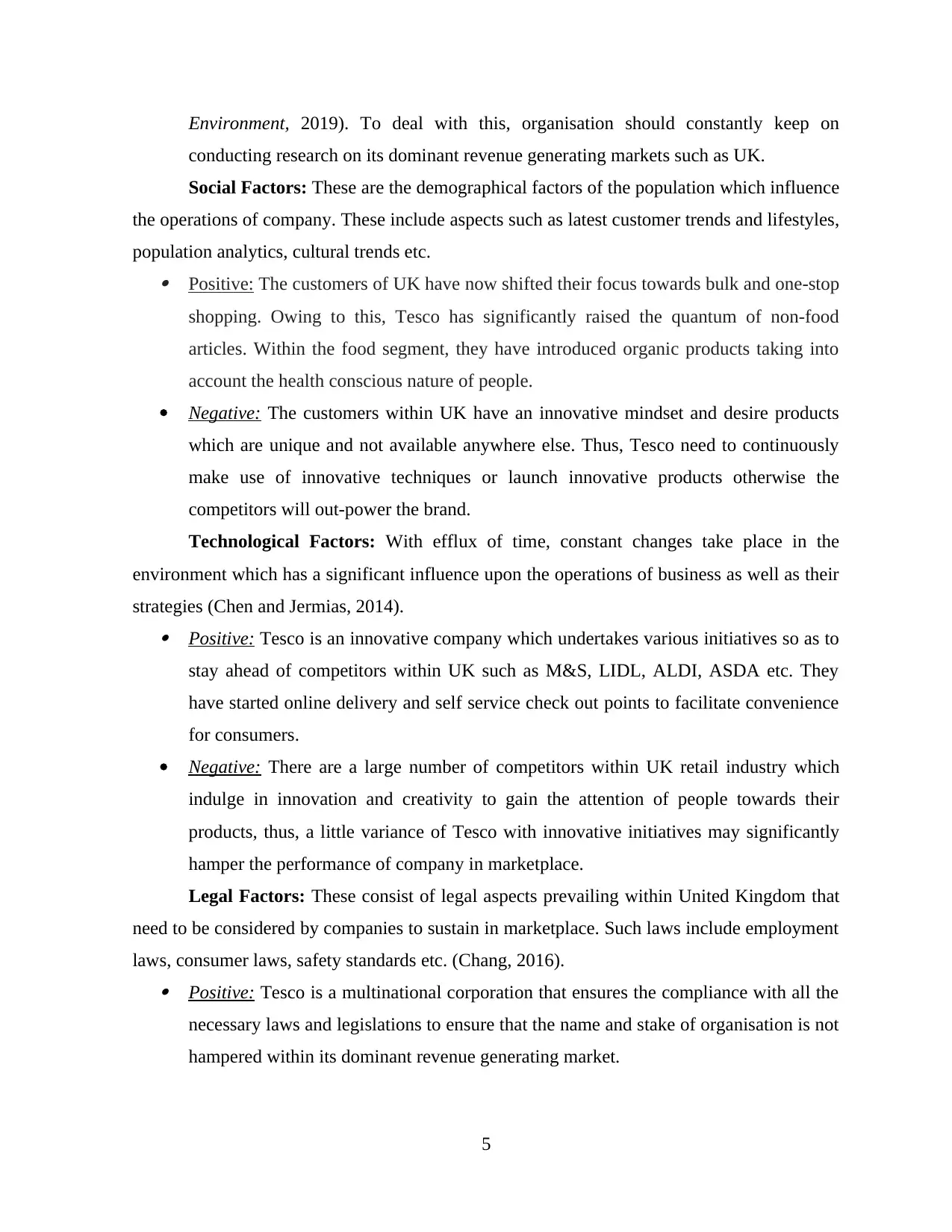
Environment, 2019). To deal with this, organisation should constantly keep on
conducting research on its dominant revenue generating markets such as UK.
Social Factors: These are the demographical factors of the population which influence
the operations of company. These include aspects such as latest customer trends and lifestyles,
population analytics, cultural trends etc.
Positive: The customers of UK have now shifted their focus towards bulk and one-stop
shopping. Owing to this, Tesco has significantly raised the quantum of non-food
articles. Within the food segment, they have introduced organic products taking into
account the health conscious nature of people.
Negative: The customers within UK have an innovative mindset and desire products
which are unique and not available anywhere else. Thus, Tesco need to continuously
make use of innovative techniques or launch innovative products otherwise the
competitors will out-power the brand.
Technological Factors: With efflux of time, constant changes take place in the
environment which has a significant influence upon the operations of business as well as their
strategies (Chen and Jermias, 2014).
Positive: Tesco is an innovative company which undertakes various initiatives so as to
stay ahead of competitors within UK such as M&S, LIDL, ALDI, ASDA etc. They
have started online delivery and self service check out points to facilitate convenience
for consumers.
Negative: There are a large number of competitors within UK retail industry which
indulge in innovation and creativity to gain the attention of people towards their
products, thus, a little variance of Tesco with innovative initiatives may significantly
hamper the performance of company in marketplace.
Legal Factors: These consist of legal aspects prevailing within United Kingdom that
need to be considered by companies to sustain in marketplace. Such laws include employment
laws, consumer laws, safety standards etc. (Chang, 2016).
Positive: Tesco is a multinational corporation that ensures the compliance with all the
necessary laws and legislations to ensure that the name and stake of organisation is not
hampered within its dominant revenue generating market.
5
conducting research on its dominant revenue generating markets such as UK.
Social Factors: These are the demographical factors of the population which influence
the operations of company. These include aspects such as latest customer trends and lifestyles,
population analytics, cultural trends etc.
Positive: The customers of UK have now shifted their focus towards bulk and one-stop
shopping. Owing to this, Tesco has significantly raised the quantum of non-food
articles. Within the food segment, they have introduced organic products taking into
account the health conscious nature of people.
Negative: The customers within UK have an innovative mindset and desire products
which are unique and not available anywhere else. Thus, Tesco need to continuously
make use of innovative techniques or launch innovative products otherwise the
competitors will out-power the brand.
Technological Factors: With efflux of time, constant changes take place in the
environment which has a significant influence upon the operations of business as well as their
strategies (Chen and Jermias, 2014).
Positive: Tesco is an innovative company which undertakes various initiatives so as to
stay ahead of competitors within UK such as M&S, LIDL, ALDI, ASDA etc. They
have started online delivery and self service check out points to facilitate convenience
for consumers.
Negative: There are a large number of competitors within UK retail industry which
indulge in innovation and creativity to gain the attention of people towards their
products, thus, a little variance of Tesco with innovative initiatives may significantly
hamper the performance of company in marketplace.
Legal Factors: These consist of legal aspects prevailing within United Kingdom that
need to be considered by companies to sustain in marketplace. Such laws include employment
laws, consumer laws, safety standards etc. (Chang, 2016).
Positive: Tesco is a multinational corporation that ensures the compliance with all the
necessary laws and legislations to ensure that the name and stake of organisation is not
hampered within its dominant revenue generating market.
5
Paraphrase This Document
Need a fresh take? Get an instant paraphrase of this document with our AI Paraphraser
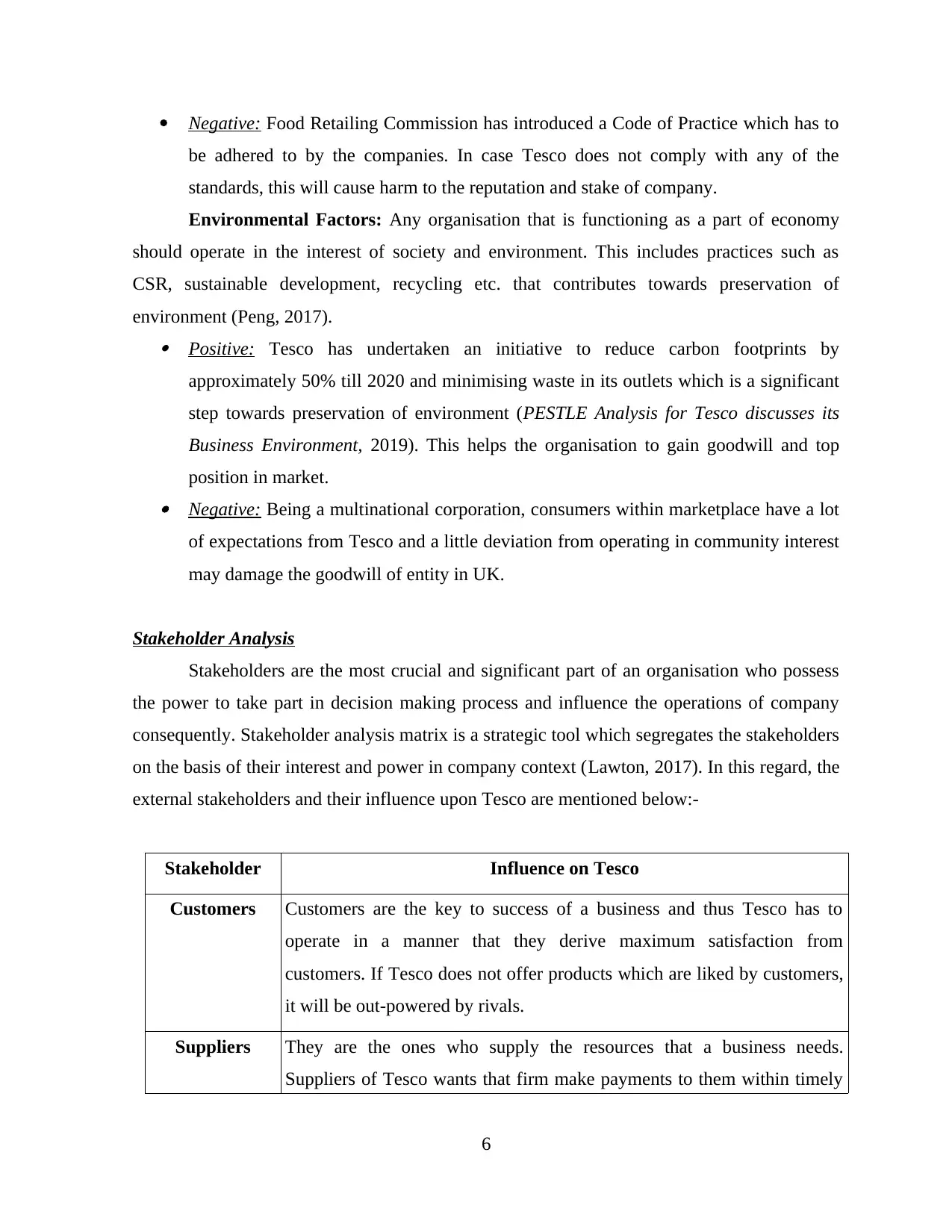
Negative: Food Retailing Commission has introduced a Code of Practice which has to
be adhered to by the companies. In case Tesco does not comply with any of the
standards, this will cause harm to the reputation and stake of company.
Environmental Factors: Any organisation that is functioning as a part of economy
should operate in the interest of society and environment. This includes practices such as
CSR, sustainable development, recycling etc. that contributes towards preservation of
environment (Peng, 2017).
Positive: Tesco has undertaken an initiative to reduce carbon footprints by
approximately 50% till 2020 and minimising waste in its outlets which is a significant
step towards preservation of environment (PESTLE Analysis for Tesco discusses its
Business Environment, 2019). This helps the organisation to gain goodwill and top
position in market.
Negative: Being a multinational corporation, consumers within marketplace have a lot
of expectations from Tesco and a little deviation from operating in community interest
may damage the goodwill of entity in UK.
Stakeholder Analysis
Stakeholders are the most crucial and significant part of an organisation who possess
the power to take part in decision making process and influence the operations of company
consequently. Stakeholder analysis matrix is a strategic tool which segregates the stakeholders
on the basis of their interest and power in company context (Lawton, 2017). In this regard, the
external stakeholders and their influence upon Tesco are mentioned below:-
Stakeholder Influence on Tesco
Customers Customers are the key to success of a business and thus Tesco has to
operate in a manner that they derive maximum satisfaction from
customers. If Tesco does not offer products which are liked by customers,
it will be out-powered by rivals.
Suppliers They are the ones who supply the resources that a business needs.
Suppliers of Tesco wants that firm make payments to them within timely
6
be adhered to by the companies. In case Tesco does not comply with any of the
standards, this will cause harm to the reputation and stake of company.
Environmental Factors: Any organisation that is functioning as a part of economy
should operate in the interest of society and environment. This includes practices such as
CSR, sustainable development, recycling etc. that contributes towards preservation of
environment (Peng, 2017).
Positive: Tesco has undertaken an initiative to reduce carbon footprints by
approximately 50% till 2020 and minimising waste in its outlets which is a significant
step towards preservation of environment (PESTLE Analysis for Tesco discusses its
Business Environment, 2019). This helps the organisation to gain goodwill and top
position in market.
Negative: Being a multinational corporation, consumers within marketplace have a lot
of expectations from Tesco and a little deviation from operating in community interest
may damage the goodwill of entity in UK.
Stakeholder Analysis
Stakeholders are the most crucial and significant part of an organisation who possess
the power to take part in decision making process and influence the operations of company
consequently. Stakeholder analysis matrix is a strategic tool which segregates the stakeholders
on the basis of their interest and power in company context (Lawton, 2017). In this regard, the
external stakeholders and their influence upon Tesco are mentioned below:-
Stakeholder Influence on Tesco
Customers Customers are the key to success of a business and thus Tesco has to
operate in a manner that they derive maximum satisfaction from
customers. If Tesco does not offer products which are liked by customers,
it will be out-powered by rivals.
Suppliers They are the ones who supply the resources that a business needs.
Suppliers of Tesco wants that firm make payments to them within timely
6
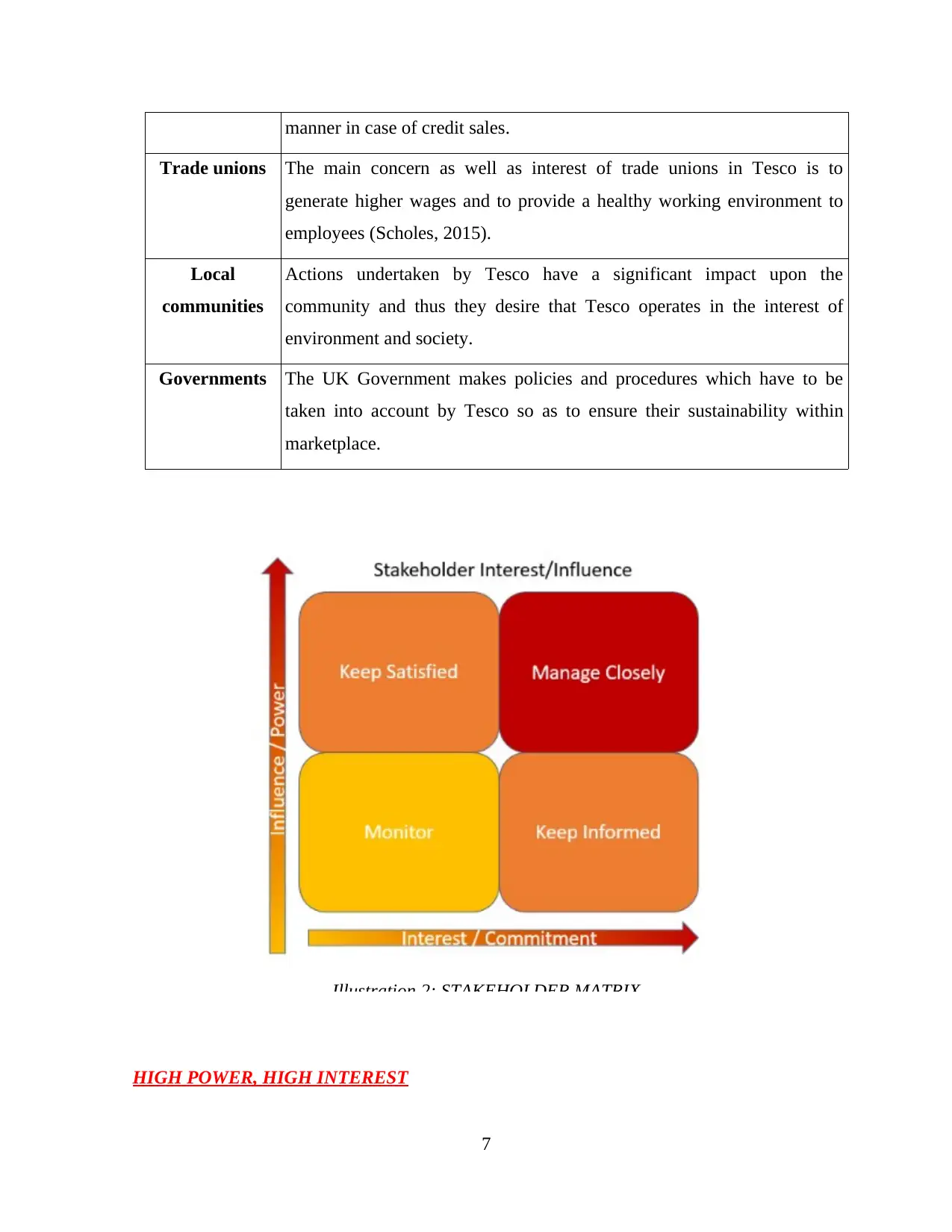
manner in case of credit sales.
Trade unions The main concern as well as interest of trade unions in Tesco is to
generate higher wages and to provide a healthy working environment to
employees (Scholes, 2015).
Local
communities
Actions undertaken by Tesco have a significant impact upon the
community and thus they desire that Tesco operates in the interest of
environment and society.
Governments The UK Government makes policies and procedures which have to be
taken into account by Tesco so as to ensure their sustainability within
marketplace.
HIGH POWER, HIGH INTEREST
7
Illustration 2: STAKEHOLDER MATRIX
Trade unions The main concern as well as interest of trade unions in Tesco is to
generate higher wages and to provide a healthy working environment to
employees (Scholes, 2015).
Local
communities
Actions undertaken by Tesco have a significant impact upon the
community and thus they desire that Tesco operates in the interest of
environment and society.
Governments The UK Government makes policies and procedures which have to be
taken into account by Tesco so as to ensure their sustainability within
marketplace.
HIGH POWER, HIGH INTEREST
7
Illustration 2: STAKEHOLDER MATRIX
⊘ This is a preview!⊘
Do you want full access?
Subscribe today to unlock all pages.

Trusted by 1+ million students worldwide
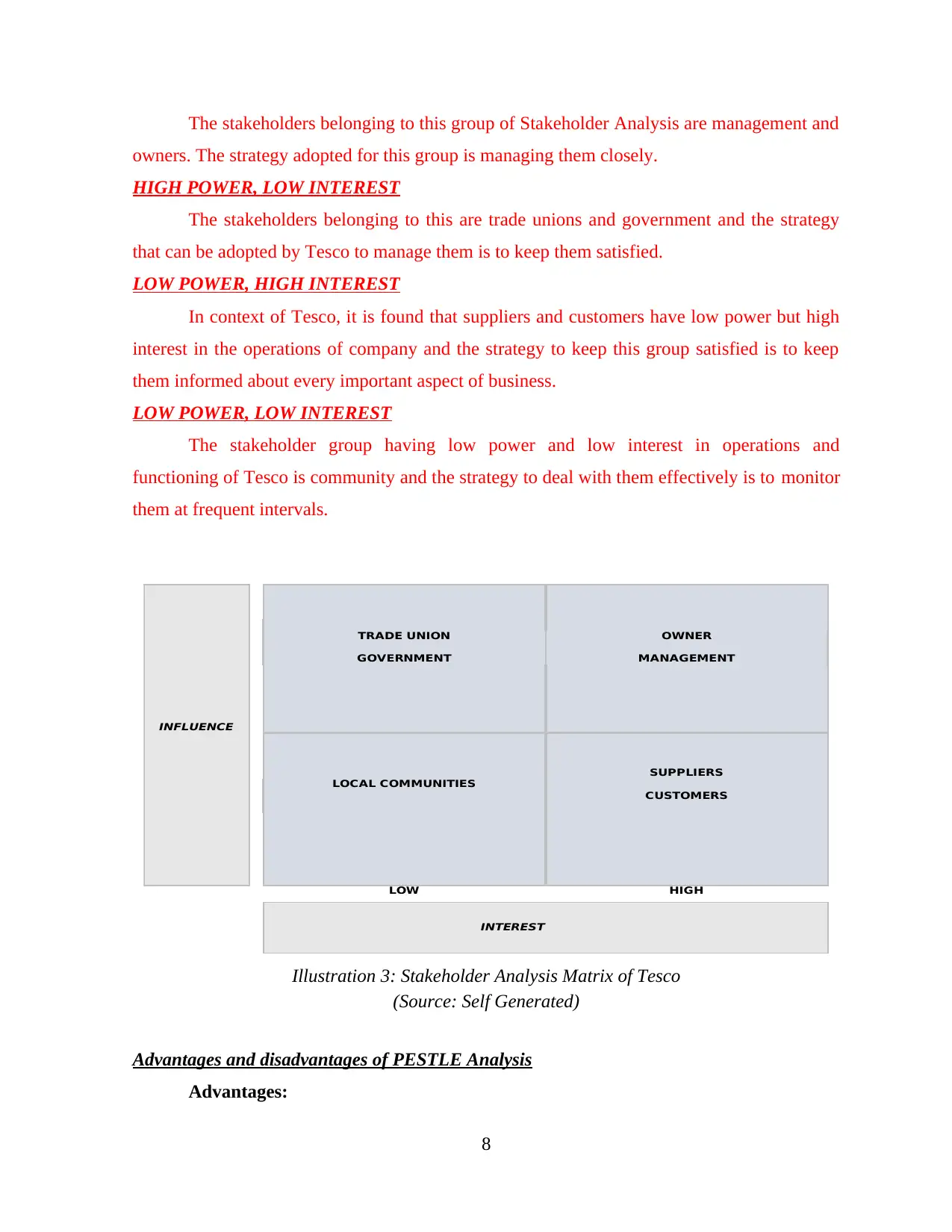
The stakeholders belonging to this group of Stakeholder Analysis are management and
owners. The strategy adopted for this group is managing them closely.
HIGH POWER, LOW INTEREST
The stakeholders belonging to this are trade unions and government and the strategy
that can be adopted by Tesco to manage them is to keep them satisfied.
LOW POWER, HIGH INTEREST
In context of Tesco, it is found that suppliers and customers have low power but high
interest in the operations of company and the strategy to keep this group satisfied is to keep
them informed about every important aspect of business.
LOW POWER, LOW INTEREST
The stakeholder group having low power and low interest in operations and
functioning of Tesco is community and the strategy to deal with them effectively is to monitor
them at frequent intervals.
(Source: Self Generated)
Advantages and disadvantages of PESTLE Analysis
Advantages:
8
TRADE UNION OWNER
GOVERNMENT MANAGEMENT
INFLUENCE
SUPPLIERS
LOCAL COMMUNITIES
CUSTOMERS
LOW HIGH
INTEREST
Illustration 3: Stakeholder Analysis Matrix of Tesco
owners. The strategy adopted for this group is managing them closely.
HIGH POWER, LOW INTEREST
The stakeholders belonging to this are trade unions and government and the strategy
that can be adopted by Tesco to manage them is to keep them satisfied.
LOW POWER, HIGH INTEREST
In context of Tesco, it is found that suppliers and customers have low power but high
interest in the operations of company and the strategy to keep this group satisfied is to keep
them informed about every important aspect of business.
LOW POWER, LOW INTEREST
The stakeholder group having low power and low interest in operations and
functioning of Tesco is community and the strategy to deal with them effectively is to monitor
them at frequent intervals.
(Source: Self Generated)
Advantages and disadvantages of PESTLE Analysis
Advantages:
8
TRADE UNION OWNER
GOVERNMENT MANAGEMENT
INFLUENCE
SUPPLIERS
LOCAL COMMUNITIES
CUSTOMERS
LOW HIGH
INTEREST
Illustration 3: Stakeholder Analysis Matrix of Tesco
Paraphrase This Document
Need a fresh take? Get an instant paraphrase of this document with our AI Paraphraser
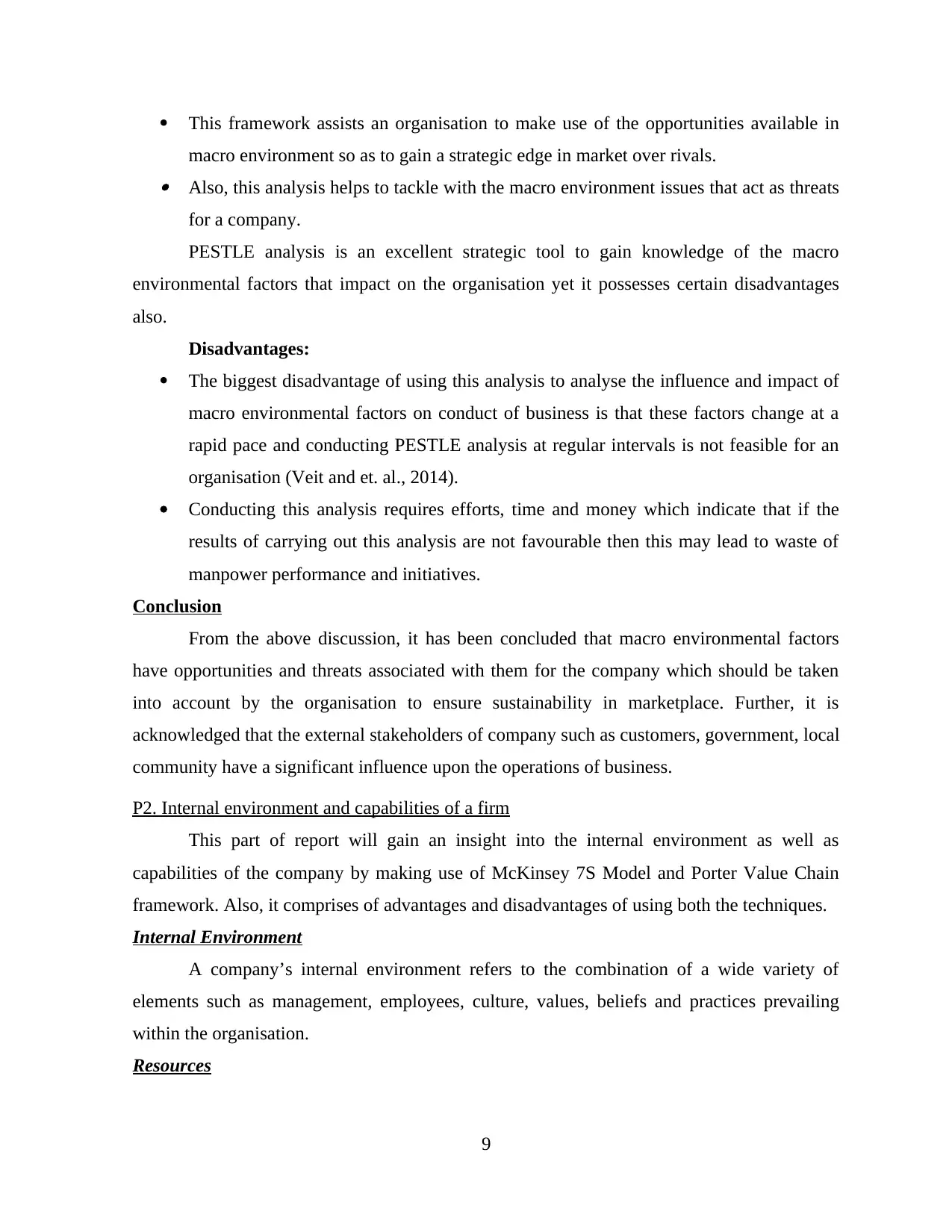
This framework assists an organisation to make use of the opportunities available in
macro environment so as to gain a strategic edge in market over rivals.
Also, this analysis helps to tackle with the macro environment issues that act as threats
for a company.
PESTLE analysis is an excellent strategic tool to gain knowledge of the macro
environmental factors that impact on the organisation yet it possesses certain disadvantages
also.
Disadvantages:
The biggest disadvantage of using this analysis to analyse the influence and impact of
macro environmental factors on conduct of business is that these factors change at a
rapid pace and conducting PESTLE analysis at regular intervals is not feasible for an
organisation (Veit and et. al., 2014).
Conducting this analysis requires efforts, time and money which indicate that if the
results of carrying out this analysis are not favourable then this may lead to waste of
manpower performance and initiatives.
Conclusion
From the above discussion, it has been concluded that macro environmental factors
have opportunities and threats associated with them for the company which should be taken
into account by the organisation to ensure sustainability in marketplace. Further, it is
acknowledged that the external stakeholders of company such as customers, government, local
community have a significant influence upon the operations of business.
P2. Internal environment and capabilities of a firm
This part of report will gain an insight into the internal environment as well as
capabilities of the company by making use of McKinsey 7S Model and Porter Value Chain
framework. Also, it comprises of advantages and disadvantages of using both the techniques.
Internal Environment
A company’s internal environment refers to the combination of a wide variety of
elements such as management, employees, culture, values, beliefs and practices prevailing
within the organisation.
Resources
9
macro environment so as to gain a strategic edge in market over rivals.
Also, this analysis helps to tackle with the macro environment issues that act as threats
for a company.
PESTLE analysis is an excellent strategic tool to gain knowledge of the macro
environmental factors that impact on the organisation yet it possesses certain disadvantages
also.
Disadvantages:
The biggest disadvantage of using this analysis to analyse the influence and impact of
macro environmental factors on conduct of business is that these factors change at a
rapid pace and conducting PESTLE analysis at regular intervals is not feasible for an
organisation (Veit and et. al., 2014).
Conducting this analysis requires efforts, time and money which indicate that if the
results of carrying out this analysis are not favourable then this may lead to waste of
manpower performance and initiatives.
Conclusion
From the above discussion, it has been concluded that macro environmental factors
have opportunities and threats associated with them for the company which should be taken
into account by the organisation to ensure sustainability in marketplace. Further, it is
acknowledged that the external stakeholders of company such as customers, government, local
community have a significant influence upon the operations of business.
P2. Internal environment and capabilities of a firm
This part of report will gain an insight into the internal environment as well as
capabilities of the company by making use of McKinsey 7S Model and Porter Value Chain
framework. Also, it comprises of advantages and disadvantages of using both the techniques.
Internal Environment
A company’s internal environment refers to the combination of a wide variety of
elements such as management, employees, culture, values, beliefs and practices prevailing
within the organisation.
Resources
9
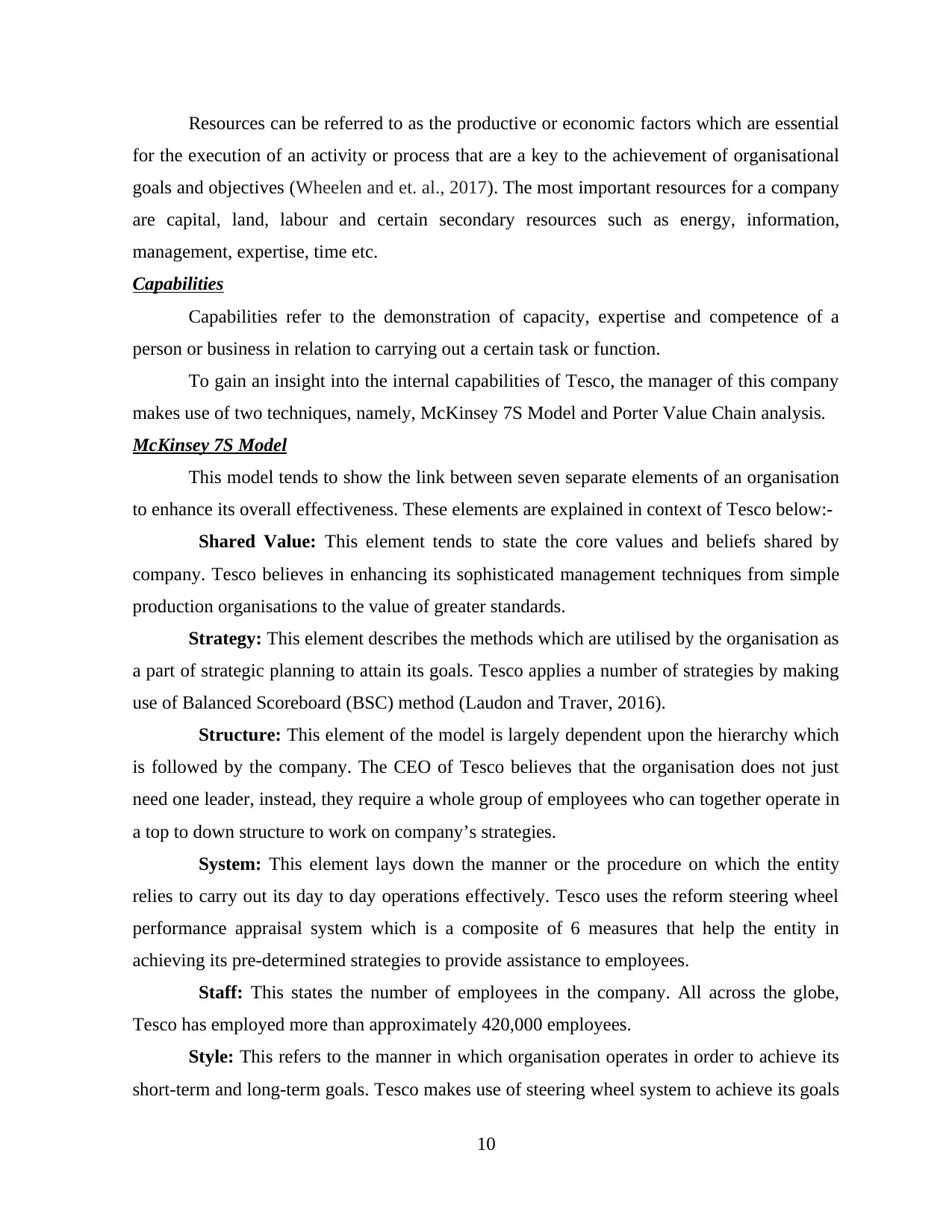
Resources can be referred to as the productive or economic factors which are essential
for the execution of an activity or process that are a key to the achievement of organisational
goals and objectives (Wheelen and et. al., 2017). The most important resources for a company
are capital, land, labour and certain secondary resources such as energy, information,
management, expertise, time etc.
Capabilities
Capabilities refer to the demonstration of capacity, expertise and competence of a
person or business in relation to carrying out a certain task or function.
To gain an insight into the internal capabilities of Tesco, the manager of this company
makes use of two techniques, namely, McKinsey 7S Model and Porter Value Chain analysis.
McKinsey 7S Model
This model tends to show the link between seven separate elements of an organisation
to enhance its overall effectiveness. These elements are explained in context of Tesco below:-
Shared Value: This element tends to state the core values and beliefs shared by
company. Tesco believes in enhancing its sophisticated management techniques from simple
production organisations to the value of greater standards.
Strategy: This element describes the methods which are utilised by the organisation as
a part of strategic planning to attain its goals. Tesco applies a number of strategies by making
use of Balanced Scoreboard (BSC) method (Laudon and Traver, 2016).
Structure: This element of the model is largely dependent upon the hierarchy which
is followed by the company. The CEO of Tesco believes that the organisation does not just
need one leader, instead, they require a whole group of employees who can together operate in
a top to down structure to work on company’s strategies.
System: This element lays down the manner or the procedure on which the entity
relies to carry out its day to day operations effectively. Tesco uses the reform steering wheel
performance appraisal system which is a composite of 6 measures that help the entity in
achieving its pre-determined strategies to provide assistance to employees.
Staff: This states the number of employees in the company. All across the globe,
Tesco has employed more than approximately 420,000 employees.
Style: This refers to the manner in which organisation operates in order to achieve its
short-term and long-term goals. Tesco makes use of steering wheel system to achieve its goals
10
for the execution of an activity or process that are a key to the achievement of organisational
goals and objectives (Wheelen and et. al., 2017). The most important resources for a company
are capital, land, labour and certain secondary resources such as energy, information,
management, expertise, time etc.
Capabilities
Capabilities refer to the demonstration of capacity, expertise and competence of a
person or business in relation to carrying out a certain task or function.
To gain an insight into the internal capabilities of Tesco, the manager of this company
makes use of two techniques, namely, McKinsey 7S Model and Porter Value Chain analysis.
McKinsey 7S Model
This model tends to show the link between seven separate elements of an organisation
to enhance its overall effectiveness. These elements are explained in context of Tesco below:-
Shared Value: This element tends to state the core values and beliefs shared by
company. Tesco believes in enhancing its sophisticated management techniques from simple
production organisations to the value of greater standards.
Strategy: This element describes the methods which are utilised by the organisation as
a part of strategic planning to attain its goals. Tesco applies a number of strategies by making
use of Balanced Scoreboard (BSC) method (Laudon and Traver, 2016).
Structure: This element of the model is largely dependent upon the hierarchy which
is followed by the company. The CEO of Tesco believes that the organisation does not just
need one leader, instead, they require a whole group of employees who can together operate in
a top to down structure to work on company’s strategies.
System: This element lays down the manner or the procedure on which the entity
relies to carry out its day to day operations effectively. Tesco uses the reform steering wheel
performance appraisal system which is a composite of 6 measures that help the entity in
achieving its pre-determined strategies to provide assistance to employees.
Staff: This states the number of employees in the company. All across the globe,
Tesco has employed more than approximately 420,000 employees.
Style: This refers to the manner in which organisation operates in order to achieve its
short-term and long-term goals. Tesco makes use of steering wheel system to achieve its goals
10
⊘ This is a preview!⊘
Do you want full access?
Subscribe today to unlock all pages.

Trusted by 1+ million students worldwide
1 out of 22
Related Documents
Your All-in-One AI-Powered Toolkit for Academic Success.
+13062052269
info@desklib.com
Available 24*7 on WhatsApp / Email
![[object Object]](/_next/static/media/star-bottom.7253800d.svg)
Unlock your academic potential
Copyright © 2020–2025 A2Z Services. All Rights Reserved. Developed and managed by ZUCOL.


